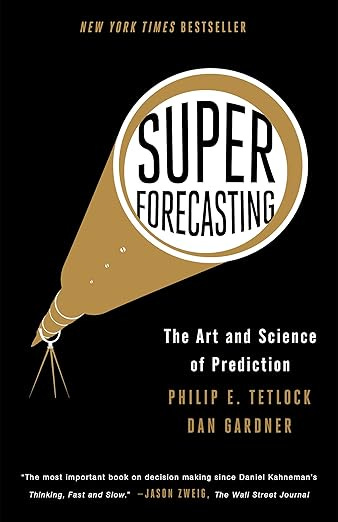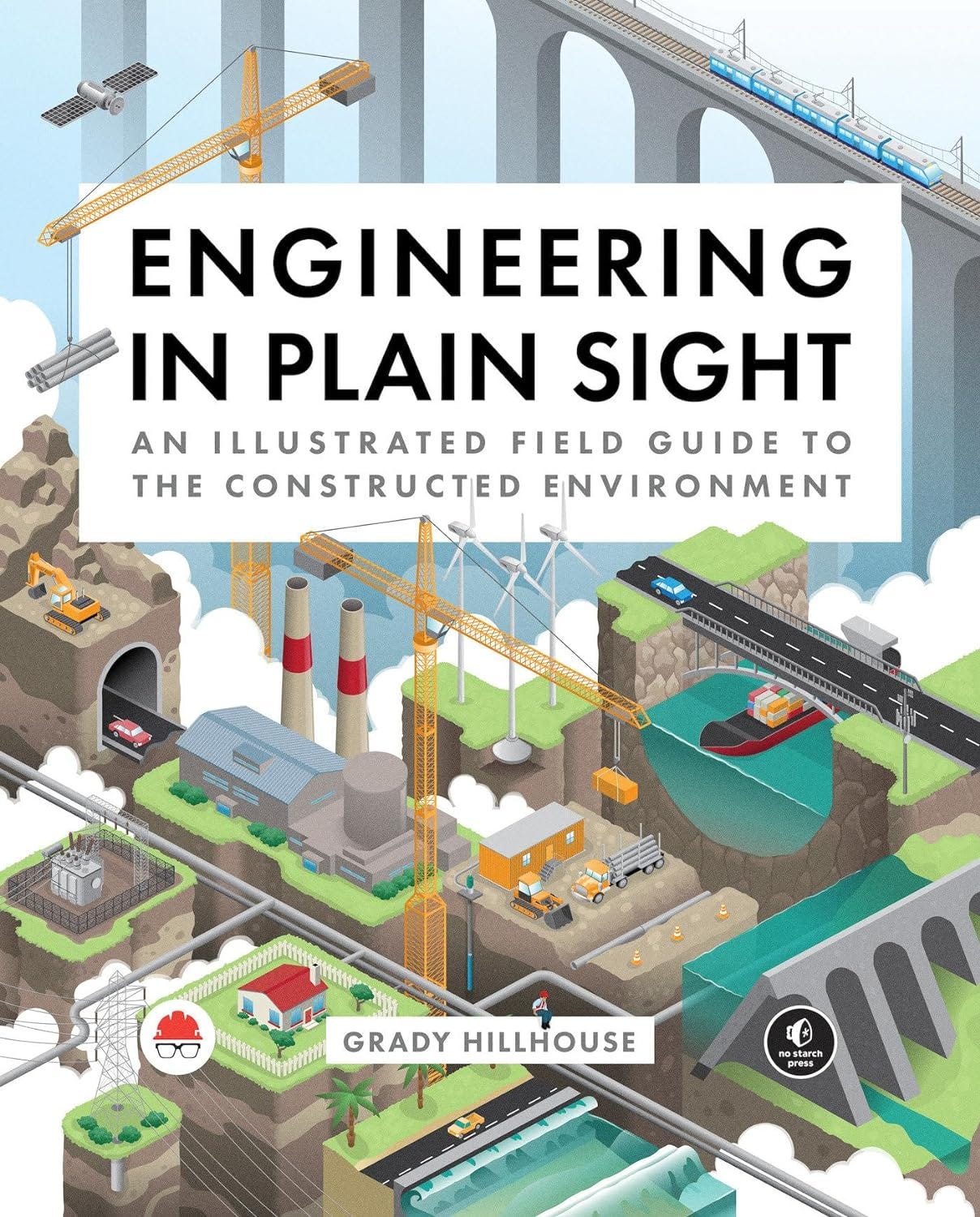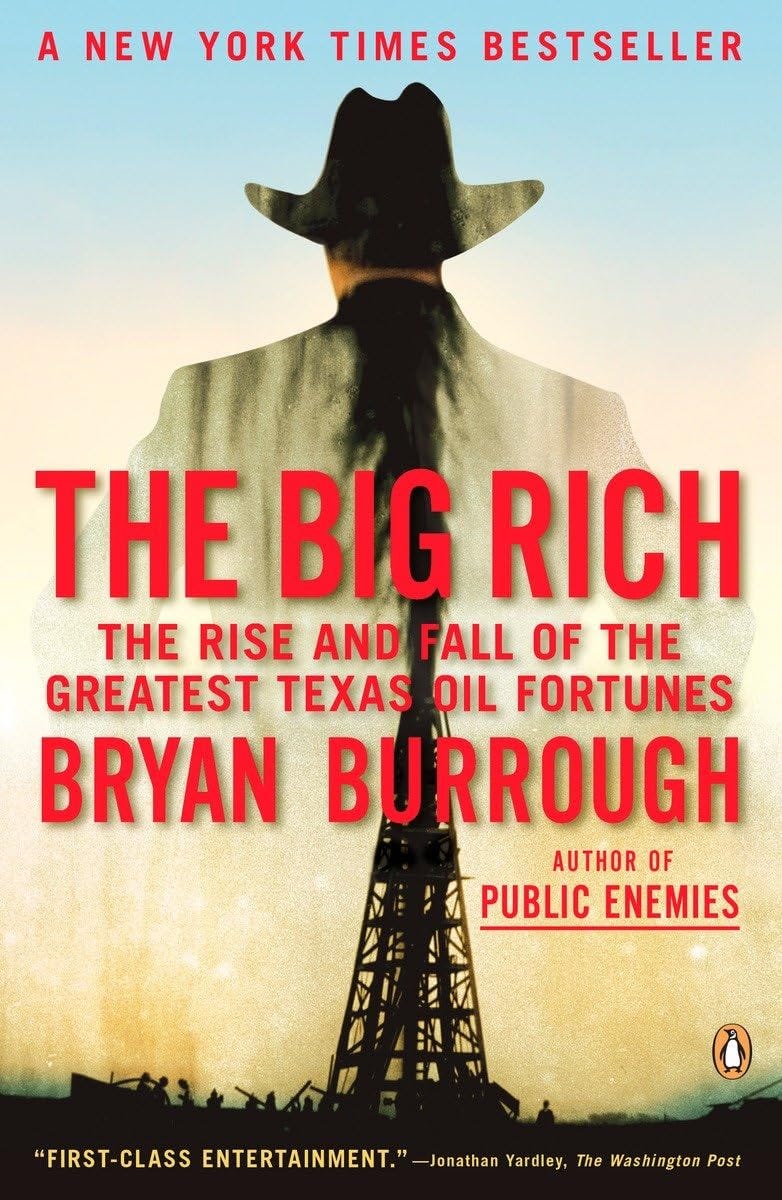This month we read:
Superforecasting: The Art and Science of Prediction by Philip E. Tetlock and Dan Gardner
Engineering in Plain Sight by Grady Hillhouse
Four Seasons: The Story of a Business Philosophy by Isadore Sharp
The Big Rich by Bryan Burough
Superforecasting: The Art and Science of Prediction by Philip E. Tetlock and Dan Gardner
I first read Superforecasting in 2016 (according to Amazon) and was overdue for a re-read. The book explains how a small sub-set of people can make significantly better forecasts than the general population. The book explains the methods they use, which is distilled into “10 commandments” of forecasting.
Triage
Focus where your efforts are mostly likely to add value. If a simple rule of thumb is reasonably accurate, don’t waste time trying to improve it. If the question is unknowable that even advanced statistical models fail, then don’t bother.
For example, trying to predict who the president will be in twelve years is impossible to forecast accurately. Don’t even try. Who could have predicted in 1940 that a little-known Army colonel named Dwight Eisenhower would win the 1952 presidential election?
Break seemingly intractable problems into tractable sub-problems.
When Enrico Fermi wasn’t building the world’s first nuclear reactor, he was a superforecaster. He would famously ask students to estimate the number of piano tuners in Chicago. He showed them how someone with no special knowledge could get a reasonably correct answer by breaking down a difficult question into smaller, more easily answered sub-questions.
Peter Backus, a lonely guy in London, guesstimated the number of potential female partners in his vicinity by starting with the population of London (approximately six million) and winnowing that number down by the proportion of women in the population (about 50%), by the proportion of singles (about 50%), by the proportion in the right age range (about 20%), by the proportion of university graduates (about 26%), by the proportion he finds attractive (only 5%), by the proportion likely to find him attractive (only 5%), and by the proportion likely to be compatible with him (about 10%). Conclusion: roughly twenty-six women in the pool, a daunting but not impossible search task.
Strike the right balance between inside and outside views.
Nothing is 100% unique. Uniqueness is a matter of degree. There is almost always some reference class to look to for a baseline.
The “outside view” is how events in the same class usually turn out. The inside view is specific knowledge that distinguishes the current event from the reference class of events.
Larry Summers, a Harvard professor and former Treasury secretary knew about the planning fallacy: employees tend to underestimate the time they need to complete a task by a factor of two or three. This was the “outside view.” Summers suspected his employees were no different, so he doubled the employee’s estimate, then moved to the next higher time unit. “So, if the research assistant says the task will take an hour, it will take two days. If he says two days, it will take four weeks.
If an employee delivered on time, Summers would update his inside view to reflect that this particular employee was not as susceptible to the planning fallacy.
Strike the right balance between under and overreacting to evidence.
John Meynard Keynes famously said, “When the facts change, I change my mind. What do you do sir?”
One of the key factors that distinguishes superforecasters from mere mortals is their ability to update their initial forecast as they learn new information. This is easier said than done because it is difficult to tease out the signal from the noise of the news.
Superforecasters update their beliefs incrementally, say from 40% to 35% or 60% to 65%. Superforecasters think more granularly than most, who would be satisfied with vague terms like “likely”, “might”, and “probably.”
This is the most useful practice I have come across for investing. Instead of thinking, “this could happen” or “this might happen” I try to pause and try to put an actual probability on it. For example, a pertinent question might be: what are the odds that Dollar General’s operating margin exceeds 8.0% in 2028? If you think it's 80 or 90%, then you might conclude DG is a good value today. If you think it's closer to 40 or 60% then it's probably too speculative. Going through the exercise is useful whether or not you invest because it will reveal what you actually know about DG’s business model and your confidence in it.
Look for the clashing causal forces at work in each problem.
The outcome of most forecasting questions are caught between strong opposing forces. Superforecasters identify the opposing forces, assign weights to them, and update those weights as the facts change.
If you’re trying to forecast whether the Assad regime will fall in Syria, you’d have to weigh the strong rebel advances, international condemnation, defections from Assad’s army, territorial losses, and sanctions against strong support from allies (Russia and Iran), Assad’s personal grip on loyalist forces, lack of a cohesive opposition, and fear among minority groups of potential retribution in a post-Assad scenario.
Most individuals are over-influenced by emotions or political beliefs and do not correctly weigh the opposing forces. Forecasters who strongly believe in the rebel cause in Syria might be blind to the strength of Assad’s friends.
Strive to distinguish as many degrees of doubt as the problem permits but no more.
Few things are either certain or impossible. And “maybe” isn’t all that informative. Your uncertainty dial needs more than three settings. Nuance matters.
People are accustomed to nuanced views when they watch sports. Watching March Madness, they won’t just say a team is favored, they’ll say a team is favored by 10 points. Tetlock argues that nuanced thinking should not be reserved for trivial questions. The same rigor should be used for all forecasting.
Strike the right balance between under- and overconfidence, between prudence and decisiveness.
Superforecasters balance two common pitfalls. Forecasters who are too certain tend to oversimplify problems, fail to sufficiently update their beliefs, and overlook critical contrary evidence. Forecasters who are overly cautious tend to hedge excessively, remain indecisive, and express vague probabilities that reflect uncertainty without offering actionable insights.
Superforecasters recognize uncertainty yet still make clear, actionable predictions, frequently revising those predictions as they integrate new information.
Look for the errors behind your mistakes but beware of rearview-mirror hindsight biases.
Superforecasters don’t try to justify or excuse their failures, they own them. They do honest post-mortems on their failures. The most common mistake is to fail to learn from prior failures. Charlie Munger used to say, “You have to rub your nose in your own mistakes.”
It’s also possible to learn too much from failures. We call this “learning the wrong lessons” at EPC. Annie Duke calls this “resulting.” It is important to check your basic assumptions, but sometimes it is just bad luck: it was a good bet but a bad outcome.
Superforecasters also do postmortems on their successes to reinforce what they did well and what could still have been improved.
Bring out the best in others and let others bring out the best in you.
Superforecasters use their teams and colleagues to their advantage. They learn the other side’s arguments so well that they can reproduce them and repeat them back. They also craft precise questions which help others clarify their arguments. They know how to disagree without being disagreeable.
Master the error-balancing bicycle.
Just as you can’t learn to ride a bicycle by reading a physics textbook, you can’t become a superforecaster by reading training manuals. Learning requires doing, with tight feedback loops.
Practice is not just going through the motions of making forecasts, or casually reading the news and tossing out probabilities. Superforecasting is the product of deliberate practice.
Matt
Engineering in Plain Sight by Grady Hillhouse
It’s easy to take for granted how amazing the world is today and how so many unseen inventions make our lives unrecognizably easier than those that lived 50 or 100 years ago. It usually takes reading about how the world really works to open my eyes and remind me how lucky we are and also how little I really understand about how modern amenities serve us.
Engineering in Plain Sight was a Bill Gates book recommendation for 2024 and it was one of the more practical books I’ve read in a long time. It’s written by a former civil engineer and it outlines, in layman’s terms, and with interesting illustrations, how all sorts of utilities work.
The book walks through the following infrastructure from how it’s built to how it is operated:
Electrical grid
different types of generation, transmission, and distribution
Communications
overhead & underground telecom equipment, radio antenna towers, satellite & cellular communications
Roadways
urban, highway, and pedestrian infrastructure and layout
Bridges & tunnels
types, cross sections, and construction
Railways
tracks, switches & signals, electrified rails
Dams, Levees, and Coastal Structures
ports, locks, levees & floodwalls, dams, spillways and outlets
Municipal water and wastewater
intakes and pump stations, wells, transmission pipelines and aqueducts
water treatment plants & distribution systems
Water towers and tanks
sanitary sewers and lift stations
storm water collection & water treatment plants
Construction
Construction site layout, cranes, construction machines & equipment
I’ve read public company reports on all of the above types of businesses and reading about them in practical terms makes the business model really sink in. This is invaluable when I go back to read these annual reports as it gives me a whole other layer of understanding about what these businesses actually do and how important they are in helping the world function. I’d highly recommend everyone pick this book up; it would make a great gift even for kids as it’s understandable enough for anyone from age 10 to 100 to pick up useful information.
Dan
Four Seasons: The Story of a Business Philosophy by Isadore Sharp
Isadore "Issy" Sharp was born in Toronto in 1931 to Polish Jewish immigrants. He got a degree in architecture and then went to work for his Dad’s construction company. He built houses and apartments until a family friend asked for his help building a 14-room motel on Toronto's outskirts.
The motel's success intrigued Sharpe and got him interested in building a higher end hotel that would cater to wealthy businessmen. He opened the first Four Seasons on Jarvis Street in downtown Toronto in 1960. It was remarkable that Sharp never set out with a grand plan to build the world's greatest luxury hotels. He stumbled into it using hard work and common sense and learned using trial and error.
While Sharp’s construction acumen helped get the Four Seasons off the ground, the company’s “special sauce” was the culture Sharp instilled. The root of the Four Season’s culture is the golden rule: treat guests how they would want to be treated. This is great in theory but easier said than done.
Sharp pulled it off by leading by example. You can’t ask employees to take good care of customers if you, as an employer, are not taking care of your employees.
“I asked John Stauss, “To what do you attribute our success in creating such a competent workforce? Most of your people had never worked in a hotel before, and many others had never worked anywhere.” “I think I can put it in two words,” John replied. “Patience and understanding.”
Treating employees well motivated them to perform at work. Making employees feel sure in their jobs got them to speak up about what could be improved. Getting employees to share the guests' pain points and their struggles allowed the Four Seasons to constantly evolve and improve. The employees on the front lines always know best but rarely feel comfortable being candid about it with upper management.
When the Four Seasons expanded into Europe, Sharp differentiated it from other luxury hotels by focusing on the North American businessman. International business travel was picking up, and Sharp realized that North American travelers had different preferences than Europeans. He built a hotel "not for dukes or duchesses, but for people who want to be treated that way, and are put off by the stuffy formality of traditional grand hotels.
Sharp was just as thoughtful about succession planning as he was building and operating hotels. He wanted to bring in the right partners to own it with him who would think long term and not maximize any year’s earnings. He eventually sold the majority of his stake to Kingdom Holding Company, controlled by the Saudi royal family, and Cascade, an investment firm controlled by Bill Gates.
In 2021 Cascade bought out the Saudis and now owns 71.25% of the Four Seasons.
Matt
The Big Rich by Bryan Burough
Boom and bust patterns are about as common and reliable of a theme in the investment and economic world as you can find, and Big Rich is an account of the early days of the Texas oil industry and the four families that benefitted the most.
Burough does a masterful job of mixing the business and economic history of the period with wildly entertaining stories about the myriad of personalities involved in the explosion of Texas oil.
One theme that rhymes with so many other boom periods is the prevalence of hucksters and shady dealers that flocked to the oil fields. This human desire to get rich quickly results in speculators and businessmen of less than pristine character flocking to the area where fortunes can be made in a matter of months. Whether in crypto or SPACs in recent years, oil in the 1930s, California in the 1830s, or the Tulip Mania of the 1600s, there always has been and always will be people eager to skirt the rules to get rich quickly. The main takeaway is if you ever find yourself in the midst of a hot industry, and there are a number that come to mind right now, always be leery and keep an eye on your wallet.
The other major theme is not only how quickly some of the richest families in America became rich thanks to the discovery of oil, but how quickly they blew through their fortune. The Cullens, Hunts, Richardsons and Murchisons were the original Four “Big Rich” families. They essentially took turns owning the title of richest family in America in the 1930s. What is shocking is barely two generations later most people have never even heard any of these names.
In fact, the Hunt family is perhaps most famous for when the Hunt brothers (second generation decedents of oil money) attempted to corner the silver market. Corner the market they did, but they also lost billions in the process. Burough dedicates a few fascinating chapters to exactly how this saga unfolded.
From de-worsification to buying way too many expensive toys to (especially) taking on tremendous debt to fund their lavish lifestyles and empire build, the fortunes that were so quickly created have largely been destroyed. If only the second generations could have gotten their hands on a few early Buffett shareholder letters explaining the importance of balance sheet strength and staying within your circle of competence, each family may still be a household name. But alas, that is capitalism at work!
Dan
The Best Of The Rest
Barron’s: AutoZone Stock Should Rev Up Even as New-Car Sales Stall
Barron’s: Philip Morris Stock Is Hot. A Lot of Credit Goes to Zyn.
Bloomberg: Oaktree's Howard Marks on Credit Yields, Trump's Tariffs
Globalization kept inflation in check. Domestic manufacturing often means higher wages, higher input costs, and less efficiency. Regardless of whether that is good or bad, it is inflationary. If inflation is structurally higher, then valuation multiples may need to adjust lower.
Instead of trying to predict, focus on how assets are priced relative to this new backdrop.“Am I being compensated fairly for the risk I’m taking?”
Barron’s: McKesson Gets Drugs to Patients. Buy the Stock for Healthy Returns.
“When you put it all together, it’s a company with really high market share, a really high-cost advantage, one that’s focused on the U.S. and a part of the economy that is less volatile.”
Bloomberg (2011): The Nixon Shock
A blast from the past, expertly written by Rodger Lowenstein, that rhymes with today. The end of Bretton-Woods was the last time the US Government upended global trade. Abandoning the gold standard and devaluing the dollar could have been seen as shameful. The administration spun it as America taking charge and righting America’s trade balance.
Another blast from the past, this time from Warren Buffett.
FDRA: 10 lessons from the past to inform how the 2025 tariffs will affect consumers, farmers, industry, economics, and politics. (h/t MBI)
Agriculture always gets hurt by tariffs, perhaps more than other industries.
Consumers pay higher prices every time.
Enactment of major tariffs always elicit retaliatory tariffs and measures.
Voters always punish the political party who enacted tariffs.
The narratives of ‘fairness,’ ‘injustice,’ combined with currency issues, keep being used to justify tariffs.
Global currency chaos emanates from large tariffs – weakening nations.
Tariffs turn into nationalistic bellicose fights and reshape global balance of power.
Tariffs create new constitutional debates and changing power dynamics among branches.
Populism, power and ideology clouds economic reality for policymakers.
Curiously, leaders know tariff policies are bad but don’t halt them."
WSJ: Edward Avedisian, a Clarinetist, Gave Away More Than $125 Million
Boston musician, who has died at age 85, used a middle-class income to build a fortune in the stock market.








